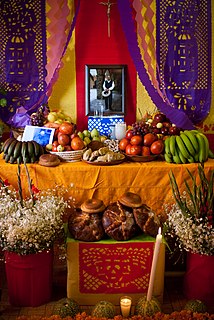
The Day of the Dead is a holiday traditionally celebrated on November 1 and 2, though other days, such as October 31 or November 6, may be included depending on the locality. It largely originated in Mexico, where it is mostly observed, but also in other places, especially by people of Mexican heritage elsewhere. Although associated with the Western Christian Allhallowtide observances of All Hallow's Eve, All Saints' Day and All Souls' Day, it has a much less solemn tone and is portrayed as a holiday of joyful celebration rather than mourning. The multi-day holiday involves family and friends gathering to pay respects and to remember friends and family members who have died. These celebrations can take a humorous tone, as celebrants remember funny events and anecdotes about the departed.

The City of Longmont is a home rule municipality located in Boulder and Weld counties, Colorado, United States. Longmont is located northeast of the county seat of Boulder and 33 miles (53 km) north-northwest of the Colorado State Capitol in Denver.

The California African American Museum (CAAM) is a museum located in Exposition Park, Los Angeles, California, United States. The Museum focuses on enrichment and education on the cultural heritage and history of African Americans with a focus on California and western United States. Admission is free to all visitors. Their mission statement is "to research, collect, preserve, and interpret for public enrichment the history, art and culture of African Americans with an emphasis on California and the western United States."
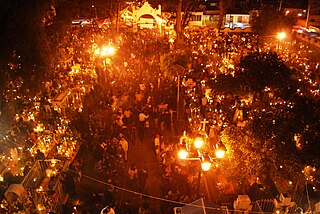
San Andres Míxquic is a community located in the southeast of the Distrito Federal in the borough of Tláhuac. The community was founded by the 11th century on what was a small island in Lake Chalco. “Míxquic” means “in mesquite” but the community's culture for most of its history was based on chinampas, gardens floating on the lake's waters and tied to the island. Drainage of Lake Chalco in the 19th and 20th century eventually destroyed the chinampas but the community is still agricultural in nature, despite being officially in the territory of Mexico City.
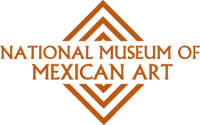
The National Museum of Mexican Art is a museum which features Mexican, Latino, and Chicano art and culture. The museum was founded in 1982 by Carlos Tortolero and Helen Valdez. Located in the Pilsen neighborhood of Chicago, Illinois, the current building in Harrison Park opened on March 27, 1987. The museum is the only Latino museum accredited by the American Alliance of Museums. The mission of the museum is to display Mexican culture as one sin fronteras. The museum describes itself as the largest Latino cultural institution in America.
El Muerto, also known as El Muerto: The Aztec Zombie, is a fictional character and comic book superhero created by American comics creator Javier Hernandez and published through his own imprint Los Comex. The comic book follows the story of 21-year-old Diego de la Muerte, who while on his way to a local Dia de los Muertos festival in Whittier, California, is abducted and sacrificed by the Aztec gods of death and destiny only to return to earth one year later with supernatural powers. The character made his first appearance in a xeroxed black-and-white preview comic titled Daze of the Dead: The Numero Uno Edition. The initial series of El Muerto was met with critical success and the character's popularity has led to several adaptations in other media including a live-action award-winning independent film starring Wilmer Valderrama.

A calavera is a representation of a human skull. The term is most often applied to edible or decorative skulls made from either sugar or clay that are used in the Mexican celebration of the Day of the Dead and the Roman Catholic holiday All Souls' Day. Calavera can also refer to any artistic representations of skulls, such as the lithographs of José Guadalupe Posada. The most widely known calaveras are created with cane sugar and are decorated with items such as colored foil, icing, beads, and feathers. They range in multiple colors.

Self-Help Graphics & Art, Inc. is a community arts center with a mix Beaux-Arts and vernacular architecture in East Los Angeles, California, United States. The building was built in 1927, and was designed by Postle & Postle. Formed during the cultural renaissance that accompanied the Chicano Movement, Self Help, as it is sometimes called, was one of the primary centers that incubated the nascent Chicano art movement, and remains important in the Chicano art movement, as well as in the greater Los Angeles community, today. SHG also hosts musical and other performances, and organizes Los Angeles's annual Day of the Dead festivities. Throughout its history, the organization has worked with well-known artists in the Los Angeles area such as Los Four and the East Los Streetscapers, but it has focused primarily on training and giving exposure to young and new artists, many of whom have gone on to national and international prominence.

Longmont High School is the original high school of the city of Longmont, Colorado, United States, and opened its doors to students in 1901. The school is located in central Longmont and serves as a high school for the St. Vrain Valley School District.

Pan de muerto, is a type of pan dulce traditionally baked in Mexico and the Mexican diaspora during the weeks leading up to the Día de los Muertos, which is celebrated from November 1 to November 2.

El Museo Latino is a museum featuring Latino and Hispanic art and history that is located at 4701 South 25th Street in South Omaha, Nebraska. Established in 1993, by Magdalena García, it is the first Latino art and history museum and cultural center in the Midwest.
Binh Danh is a Vietnamese-born photographer and artist. He immigrated with his parents to the United States in 1979.

Huaquechula is a town in Huaquechula Municipality located in state of Puebla in central Mexico. The settlement dates back at least as far as 1110 CE although its center has moved to twice to its current location. Since its founding, it has been an agricultural community, today raising crops such as peanuts, corn and sorghum, although there are some handcrafts as well. The town is known for its traditions related to the Feast of the Cross, but even more so for its “cabo del año” altars on Day of the Dead, which are dedicated to family members who have died during the previous year. These have been declared a cultural heritage of the state of Puebla and bring tourists to the town, mostly from Puebla.
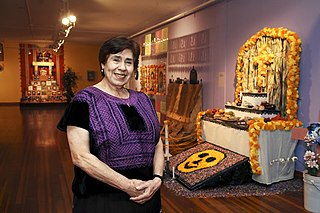
Herminia Albarrán Romero is a Mexican-American artist known for her papel picado and altar-making. She received a National Heritage Fellowship from the National Endowment for the Arts in 2005, which is the United States' highest honor in the folk and traditional arts.

The Museo de la Historia de Ponce is a museum located in the historic Casa Salazar-Candal in the city of Ponce, Puerto Rico. The museum depicts the city's ecology, economy, architecture, government, and elements of daily life. It seeks to promote the research, conservation, and dissemination of the historic heritage of Ponce and Puerto Rico.

St. Vrain State Park, formerly known as Barbour Ponds is a Colorado state park. The park hosts year-round camping. It is a popular birding destination, hosting the states largest rookery of Blue Heron, it is home to several other bird species as well including migrating waterfowl, songbirds and the occasional bald eagle. Other park activities include year round fishing and hiking. There are plans for a reservoir to be built at the park named Blue Heron Reservoir.
The Sonoma Valley Museum of Art is an art museum located in Sonoma, California, United States. Founded in 1998, the museum exhibits works by regional, national and international modern and contemporary artists.

An ofrenda is the offering placed in a home altar during the annual and traditionally Mexican Día de Muertos celebration. An ofrenda, which may be quite large and elaborate, is usually created by the family members of a person who has died and is intended to welcome the deceased to the altar setting.
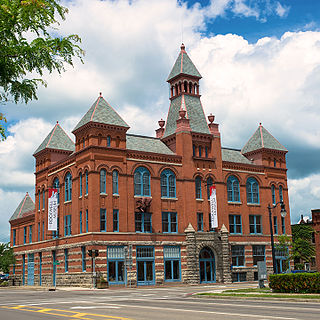
The Rockwell Museum is a Smithsonian Affiliate museum of American art located in the Finger Lakes region in downtown Corning, New York. Frommer's describes it as "one of the best-designed small museums in the Northeast." In 2015, The Rockwell Museum was named a Smithsonian Affiliate, the first in New York State outside of New York City.
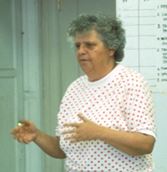
Karen Boccalero was an American nun, fine artist, and founder and former director of Self-Help Graphics & Art.

















